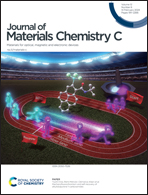Strain-driven topological quantum phase transition in (pseudo)cubic (mixed)-Cs/MA/FA halide perovskites†
Abstract
The centrosymmetric halide perovskites undergo a continuous phase transition from a trivial to topological insulator at the critical value of strain. Contrarily, in noncentrosymmetric halide perovskites, this phase transition is discontinuous. The noncentrosymmetry does not stabilize the gapless state, causing discontinuity in the bandgap. We have employed density functional theory and Slater–Koster formalism-based tight-binding Hamiltonian studies to understand the evolution of band topology under compressive strain. Our study shows that both cubic and pseudocubic FAPbI3 undergo a Pb s–p band inversion at γ (V/V0) = 0.76 and 0.73, respectively. The pseudocubic structure shows two conducting states around, M![[> with combining overline]](https://www.rsc.org/images/entities/char_003e_0305.gif) unlike the cubic counterpart. The Pb–Pb second nearest neighbor interactions determine this topological phase transition. Alongside, we have modeled mixed cation halide perovskites CsxMA1−xPbI3 (x = 0.25, 0.50 and 0.75) to study their topological properties. In addition, the structural stability of different strained configurations strengthens the experimental relevance.
unlike the cubic counterpart. The Pb–Pb second nearest neighbor interactions determine this topological phase transition. Alongside, we have modeled mixed cation halide perovskites CsxMA1−xPbI3 (x = 0.25, 0.50 and 0.75) to study their topological properties. In addition, the structural stability of different strained configurations strengthens the experimental relevance.



 Please wait while we load your content...
Please wait while we load your content...